NAZIS FORCE BULGE IN ALLIED LINES
Adlerhorst Forward HQ, Central Hessen, Germany • December 16, 1944
“It is essential to deprive the enemy of his belief that victory is certain,” Adolf Hitler told his generals on December 12, 1944, at his rural Adlerhorst (Eagle’s Nest) headquarters near Bad Nauheim, Germany, the camouflaged western command outpost Architect of the Reich Albert Speer (pronounced “spare”) had built for him in 1939–1940. “Our task is to teach the enemy by ruthless strikes that he hasn’t yet won, and that the war will continue without interruption.” Four days later, on this date in 1944, elements of 4 German armies, comprising nearly 300,000 German troops in 14 infantry and 5 armored (panzer) divisions, smashed through the hilly, snow-covered Ardennes Forest in bitterly cold Belgium and Luxembourg, their massive onslaught trapping thousands of surprised and stunned American soldiers in what became known as the Battle of the Bulge, or the Ardennes Offensive. (See map below.) In a nationwide radio address shortly after his audacious offensive began, Hitler exhorted his countrymen: “Be confident! Whatever may face us, we will overcome it. There is victory at the end of the road. Under any situation, in battle where the fanaticism of a nation is a factor, there can only be victory!”
The key to the German victory in the northern sector were “Rollbahns” (primary thrust routes) that lined up with the Allied-held Belgian supply port of Antwerp—lifeline of the Allies in Western Europe—and the German border near Aachen. Never able to open these land routes, the Germans failed to achieve 3 objectives: retaking Antwerp inside a week, driving a wedge between the American and British-Canadian armies, and forcing a negotiated armistice on their Western Front. To the south, in the center of the bulge, the Germans had more success capturing the key Belgian-German road and railroad node in St. Vith, ordered evacuated as a liability now by Americans on December 21 after suffering over 12,500 casualties and MIAs across four divisions. Because the German plan called for the capture of St. Vith by the evening of December 17 latest, a day after the start of the Ardennes Offensive, the prolonged action in and around St. Vith dealt a major setback to their timetable.
The Germans failed, however, to take the key town of Bastogne (population 3,500) southwest of St. Vith. U.S. Brig. Gen. Anthony McAuliffe, peppery acting commander of the below-strength 101st Airborne Division (“Screaming Eagles”) trapped at Bastogne, vital intersection of one railroad and seven hardtop highways, famously snapped “Nuts!” on hearing the German surrender ultimatum. The ultimatum threatened McAuliffe’s men and the townspeople with annihilation by an allegedly overwhelming number of German troops, tanks, and artillery. Puzzled, the German truce delegation was informed that “in plain English” the expression “Nuts” meant “Go to hell!”
Elements of Gen. George S. Patton’s U.S. Third Army, driving northward, relieved the stubborn Bastogne defenders on December 26. Germany’s desperate offensive came to a complete halt in early January 1945 amid great losses on all sides. It was the bloodiest of the battles U.S. forces experienced in World War II. Overall casualties suffered by the 610,000 American troops (strength as of December 22/23, 1944) who fought during the Ardennes Offensive (December 16, 1944, to January 25, 1945) numbered 75,842, including 8,407 killed, 46,170 wounded, and nearly 21,000 captured. Equipment losses included some 730 tanks and tank destroyers. British losses totaled 1,408, including 200 dead. Perhaps as many as 2,500 Belgian and 500 Luxembourgers perished during the offensive, a third of them in Allied air raids. Nearly 90,000 people were rendered homeless. Estimates of losses on the German side range between 60,000 and 100,000, including at least 11,000 killed. Aside from the human toll, the Germans lost 600 irreplaceable tanks and assault guns and about 1,000 aircraft. By the end of Hitler’s forlorn military venture into Belgium and Luxembourg, the Nazi leader’s Wehrmacht was a spent force. The net effect of the Fuehrer’s eleventh-hour gamble was to delay the Allied conquest of Germany by just 6 weeks.
Opening Salvo in the Ardennes Offensive, aka Battle of the Bulge, December 1944
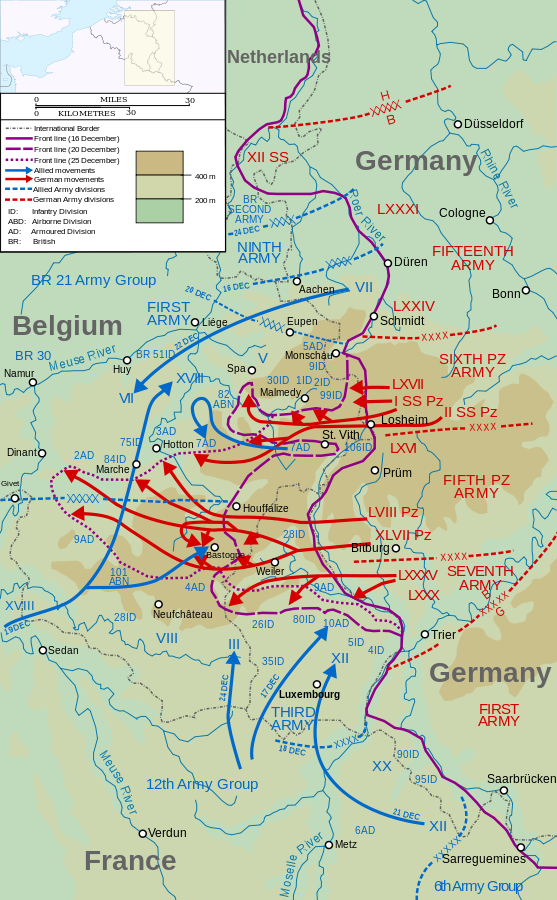 |
Above: Ardennes Offensive (Battle of the Bulge), better known by present-day Germans as Unternehmen Wacht am Rhein (Operation Watch on the Rhine) than by its later cover name, Herbstnebel (Autumn Mist). The Germans were counting on their offensive, which targeted the weakest part of the Allied front, turning the tide of war or at least postponing defeat in the West. (In the East, where the whole front threatened to collapse, Hitler had pretty much lost interest.) The map shows Germans swelling “the Bulge,” as Prime Minister Winston Churchill famously dubbed the dangerous German salient (red arrows, purple lines), between December 16 and 26, 1944. The Allies crushed the Bulge in January 1945. It was a costly price the enemy paid for Hitler’s last folly.
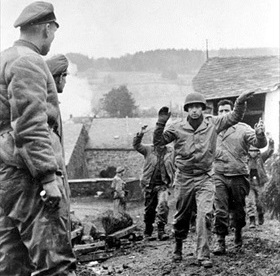 | 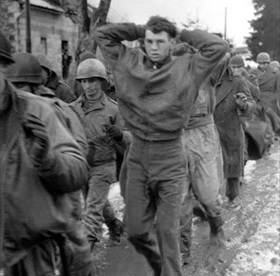 |
Left: As many as 44 soldiers of the 3rd Battalion, U.S. 119th Infantry Division were taken prisoner in Stoumont, Eastern Belgium, on December 19, 1944, by men of the 1st SS Panzer Division “Leibstandarte Adolf Hitler,” of which Kampfgruppe (battle group) Peiper was a part. Assigned a decisive role in the Ardennes Offensive, Lt. Col. Joachim (Jochen) Peiper’s black-garbed panzergrenadiers earned a murderous reputation among GIs, particularly for the horrific massacre of 84 (out of 114) disarmed U.S. artillerymen, infantrymen, medical personnel, and military police in a frozen field 3 miles/4.8 km outside Malmedy, Belgium (see map). (Peiper’s men continued riddling the bodies of fallen and dead soldiers with machine-gun and pistol rounds as their long snaking convoy of 600 vehicles passed the scene of execution.) Stiffened American resistance stoked by hatred and revenge forced Kampfgruppe Peiper, perilously low on infantry ammunition and fuel, to abandon its goal of reaching the Meuse River. After destroying and discarding equipment, a minority of men led by Peiper himself trudged eastward on December 24 through deep Belgian snow and intense cold, swam an icy river, and reached German lines on Christmas Day. Of Peiper’s 5,000 SS warriors at the start of the Ardennes Offensive, less than 800 survived.
![]()
Right: On Sunday, December 17, 1944, 24 hours after setting off, Peiper’s Kampfgruppe reached an American fuel dump in Buellingen, Belgium, where 200 U.S. soldiers from the 2nd Infantry Division were taken prisoner and forced to refuel Peiper’s Mark V Panthers and smaller Mark IV tanks, half-tracks, and other vehicles. This German photograph may show some of the men from the 2nd Infantry Division being marched back to German lines, where they were locked in POW cages. Nineteen of their comrades in the small Belgian village of Honsfeld (now part of Buellingen) were literally caught napping. From their sleeping quarters they were hustled outside in their boxer shorts and shot dead, with the exception of one GI who was thrown under the treads of a tank. Two villagers forced to face a wall were shot dead in the back of the head.
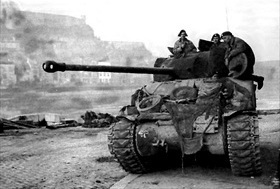 | 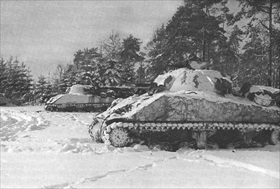 |
Left: During the Ardennes Offensive, the British 29th Armoured Brigade formed part of the defensive line on the Meuse River, the center of 1 of 3 German attack routes to the west. Tanks of the 3rd Royal Tank Regiment met the vanguard of the German push to the river before the German panzers were turned back. Field Marshall Bernard Law Montgomery, commander of the British 21st Army Group, was one of the first Allied commanders to realize the gravity of the Ardennes breakthrough. Monty ordered British Army units to position themselves at strategic crossings over the Meuse River, the center of 1 of 3 German attack routes to the west. This photo shows a British Sherman “Firefly” tank in the Southern Belgian town of Namur on the Meuse River, December 1944. The Firefly was a British variant of the American M4 Sherman tank and was fitted with the longer and far more powerful British 17‑pounder/3‑in/76.2 mm high-velocity gun as its main weapon. It was highly valued as the only British tank capable of defeating German Mark V Panther and Mark VI Tiger tanks.
![]()
Right: M4 Sherman tanks of the U.S. 7th Armored Division in temporary defensive positions near St. Vith, Belgium, a critical road and rail center needed by the Germans to supply their Ardennes Offensive. Lt. Gen. William Simpson’s U.S. Ninth Army’s 7th Armored Division was transferred to Lt. Gen. Courtney Hodges’ U.S. First Army, under the overall command of 12th Army Group Gen. Omar Bradley, and ordered to the Ardennes. Over the course of almost a week, the 7th and elements of other front-line divisions absorbed much of the weight of the German drive, throwing the German timetable into great disarray, before being forced to fall back to entrenched positions to the west on December 23, 1944.
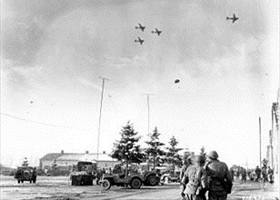 |  |
Left: After low-lying fog had lifted, troops of the 101st Airborne Division watch C‑47 Skytrains dispatched from England, escorted by P‑47 Thunderbolts, drop 192 tons of ammunition, 12 tons of gasoline, and 35 tons of provisions and medical supplies to them in the small Southeast Belgian road hub of Bastogne, December 26, 1944. Bastogne’s defenders were ringed by a mass of German troops and tanks intent on reaching the Meuse River to the northwest. The P‑47s tarried long enough to plaster the enemy with machine-gun fire and bombs. On the ground Gen. George Patton’s Third Army disengaged from its own offensive in the German Saar region and wheeled north toward Bastogne. The 4th Armored Division, Patton’s spearhead, made contact with the 101st Airborne on the same day as this airdrop. The relief of Bastogne and the prolonged action in and around St. Vith and elsewhere dealt a major setback to the German advance, almost halted now by a lack of gasoline and other supplies, destroyed bridges, and strafed- and bomb-damaged roads clogged with destroyed German armor. Soon the great bulge began to resemble a gigantic Allied pincer rather than a great German threat as U.S. divisions reclaimed lost ground. As the year ended, so did Hitler’s dream of ultimate victory in the West.
![]()
Right: The imposing 12-meter/nearly 40-ft. tall Mardasson Memorial near Bastogne, Belgium, unveiled in 1950, honors the memory of the 76,000 American soldiers who were killed, wounded, or went missing during the Ardennes Offensive. In September 2025 the large central atrium of the 5‑pointed star-shaped memorial, which bears the names of the then 48 U.S. states, was still off-limit to visitors owing to restoration problems.
Contemporary Newsreel Accounts of the Ardennes Offensive (Battle of the Bulge) Recorded by U.S. and German Cameramen
![]()

 History buffs, there is good news! The Daily Chronicles of World War II is now available as an ebook for $4.99 on Amazon.com. Containing a year’s worth of dated entries from this website, the ebook brings the story of this tumultuous era to life in a compelling, authoritative, and succinct manner. Featuring inventive navigation aids, the ebook enables readers to instantly move forward or backward by month and date to different dated entries. Simple and elegant! Click
History buffs, there is good news! The Daily Chronicles of World War II is now available as an ebook for $4.99 on Amazon.com. Containing a year’s worth of dated entries from this website, the ebook brings the story of this tumultuous era to life in a compelling, authoritative, and succinct manner. Featuring inventive navigation aids, the ebook enables readers to instantly move forward or backward by month and date to different dated entries. Simple and elegant! Click 











